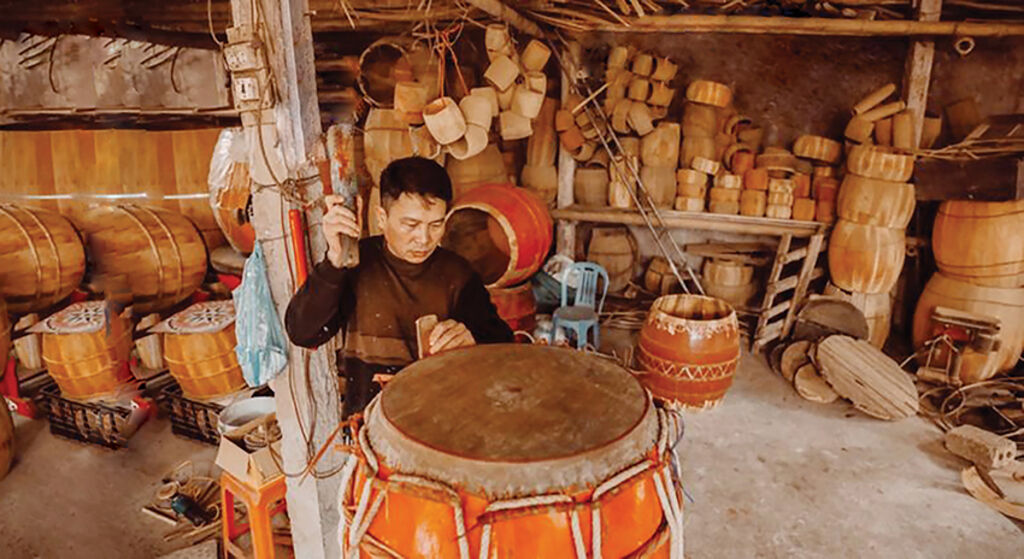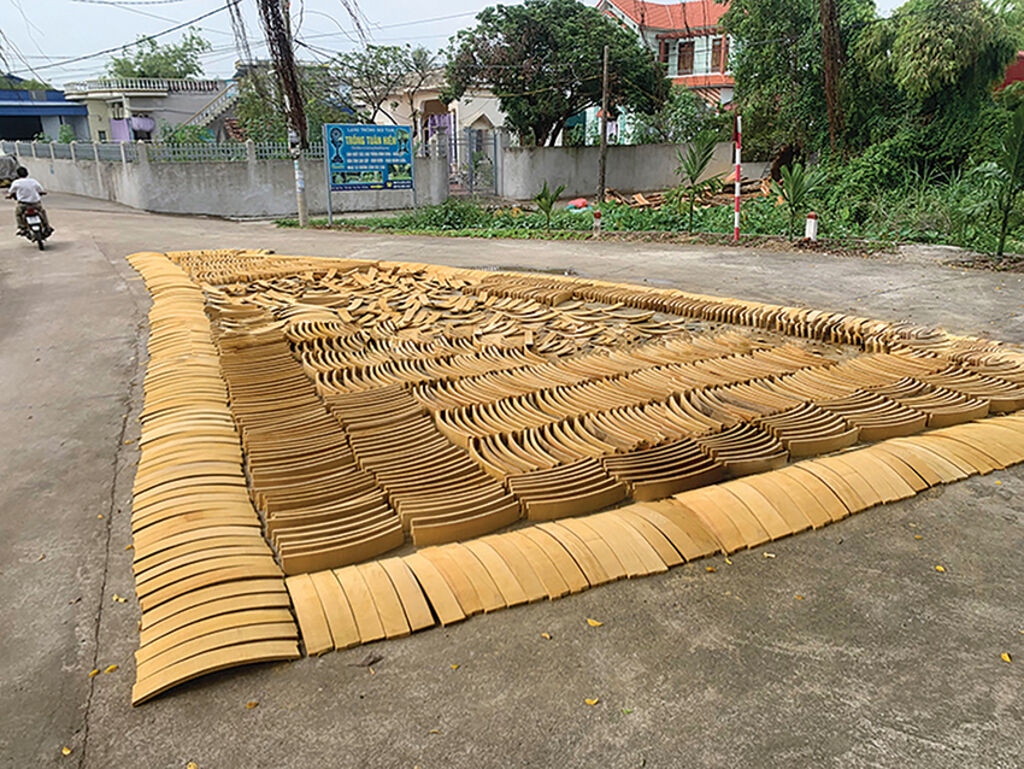 |
| Drum-making secrets only handed down to sons__Photo: https://langnghetrongdoitam.net/ |
The sound of drums has become familiar with Vietnamese people from past to present.
In the past, drums used to be played in battlefields to raise soldiers’ morale during the fight and celebrate the triumph. Nowadays, drums are indispensable instruments in folk orchestra and played at various events, ranging from art performances to religious and belief ceremonies.
Although Doi Tam village is not the only place where drums are produced, it can be said that drums of the best quality are those made here.
Located in Doi Son commune, Duy Tien district, Ha Nam province, the village has long been famous for the craft of making drums. The most well-known product of the village is a drum set, with the largest-ever thunder drum, played at the Millennium Anniversary of Thang Long-Hanoi in 2000.
 |
| Leaving jackfruit curved planks out to dry__Photo: https://tronggodoitam.net/ |
Doi Tam villagers believe that the founder of the drum-making craft was a man called Nguyen Duc Nang, who was born in 925 and passed away in 990. Legend has it that when Nang heard about King Le Dai Hanh’s visit to the village to attend a plowing ceremony, he and his brother chopped down the biggest jackfruit tree in his garden for timber and killed the biggest buffalo for leather to make a giant drum. In the spring of 987, the drum was played at the plowing ceremony at the witness of King Le Dai Hanh. The King was much impressed with the sound of the drum and bestowed the title of “Trang Sam” (the Drum Master) on Nang in recognition of his outstanding drum-making skills. In 1010, when King Ly Thai To and his court traveled across Doi mountain during their trip from Hoa Lu to Dai La, the former name of Thang Long-Hanoi, they were welcomed by Doi Tam villagers playing drums which roared like thunder. The King then issued an order allowing Doi Tam villagers to move to the capital to make drums for royal festivals. This was the start of foundation and development of a guild of drum makers in the capital city which was located somewhere in the area of Hang Trong street today.
 |
| Drying buffalo leather piece in the sun__photo: https://tronggodoitam.net/ |
Making a good drum with the right sound demands not only great care and expertise but also precision, physical strength and secrets that have been handed down over generations.
To make a barrel-shaped drum, Doi Tam craftsmen have to follow three major steps: making the drum barrel, tanning buffalo leather, and stretching the drumhead.
 |
| Stretching leather piece to make drumhead__Photo: Duc Dung/BNEWS/VNA |
Nowadays, Doi Tam craftsmen are still making drum barrels as the way their ancestors did in the past. They are still loyal to the traditional techniques of choosing timber, usually jackfruit timber, cutting the timber into planks and turning straight planks into curved ones. At the very first stage of making a drum barrel, the drum maker cuts the timber log into planks of the designed size. After curving the planks, he leaves them out to dry. He then binds sun-dried curved planks with a hoop and coats them with the wax-tree sap several times for the sap to cover gaps between the planks.
 |
| Different types of Doi Tam drums__Photo: Duc Dung/BNEWS/VNA |
Buffalo skin processing is perhaps the hardest job in the drum-making process. After fat and excessive skin are removed, the leather piece is sewed to a metal frame to be stretched out as flat as possible to dry in the sun. This step requires not only preciseness but also toughness to avoid possible rips. Drying leather is the last step of the leather processing. The leather must be dried for two days otherwise it will rot. Therefore, in case of bad weather, drum makers use sawdust and straw to smoke the skin for 12 hours. After being completely dried, the leather piece is cut into round shape to make drumheads.
Attaching the buffalo leather to the drum barrel is the final part of the drum-making process. It is considered the most difficult part as it requires the drum maker’s skill to test the sound. At this stage, the drum maker covers the leather piece onto the drum barrel. He then jumps on the drumhead to make it flat and stretch as much as possible until the leather is very strong and tough. He then checks the sound of the drum by beating on the surface and once he satisfies with the sound of the drum, he will fix the leather piece to the barrel with sharp bamboo nails.
The drum maker then puts the final touch on the drum, removing fur left on the drumhead and painting decorative patterns on the drumhead and drum barrel. The drum is now ready to be handed over to its new owner.-









